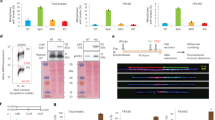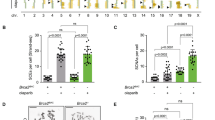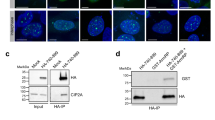Abstract
Chromosomal instability (CIN) is a hallmark of tumour initiation and progression1. Some genomic regions are particularly unstable under replication stress, notably common fragile sites2 (CFSs) whose rearrangements in tumour cells contribute to cancer development. Recent work has shown that the Fanconi anaemia (FANC) pathway plays a role in preventing defective chromosome segregation and CIN under conditions of replication stress3. Strikingly, FANCD2 is recruited to regions hosting CFSs on metaphase chromosomes4. To decipher the mechanisms protecting CFSs in G2/M, we searched for proteins that co-localize with FANCD2 on mitotic chromosomes, and identified XPF–ERCC1 and MUS81–EME1, two structure-specific endonucleases. We show that depletion of either ERCC1 or MUS81–EME1 affects accurate processing of replication intermediates or under-replicated DNA that persist at CFSs until mitosis. Depletion of these endonucleases also leads to an increase in the frequency of chromosome bridges during anaphase that, in turn, favours accumulation of DNA damage in the following G1 phase.
This is a preview of subscription content, access via your institution
Access options
Subscribe to this journal
Receive 12 print issues and online access
$209.00 per year
only $17.42 per issue
Buy this article
- Purchase on Springer Link
- Instant access to full article PDF
Prices may be subject to local taxes which are calculated during checkout





Similar content being viewed by others
References
Hanahan, D. & Weinberg, R. A. Hallmarks of cancer: the next generation. Cell 144, 646–674 (2011).
Durkin, S. G. & Glover, T. W. Chromosome fragile sites. Annu. Rev. Genet. 41, 169–192 (2007).
Naim, V. & Rosselli, F. The FANC pathway and BLM collaborate during mitosis to prevent micro-nucleation and chromosome abnormalities. Nat. Cell Biol. 11, 761–768 (2009).
Chan, K. L., Palmai-Pallag, T., Ying, S. & Hickson, I. D. Replication stress induces sister-chromatid bridging at fragile site loci in mitosis. Nat. Cell Biol. 11, 753–760 (2009).
Debatisse, M., Le Tallec, B., Letessier, A., Dutrillaux, B. & Brison, O. Common fragile sites: mechanisms of instability revisited. Trends Genet. 28, 22–32 (2012).
Gorgoulis, V. G. et al. Activation of the DNA damage checkpoint and genomic instability in human precancerous lesions. Nature 434, 907–913 (2005).
Bartkova, J. et al. DNA damage response as a candidate anti-cancer barrier in early human tumorigenesis. Nature 434, 864–870 (2005).
Le Tallec, B. et al. Molecular profiling of common fragile sites in human fibroblasts. Nat. Struct. Mol. Biol. 18, 1421–1423 (2011).
Letessier, A. et al. Cell-type-specific replication initiation programs set fragility of the FRA3B fragile site. Nature 470, 120–123 (2011).
Naim, V. & Rosselli, F. The FANC pathway and mitosis: a replication legacy. Cell Cycle 8, 2907–2911 (2009).
Kee, Y. & D’Andrea, A. D. Molecular pathogenesis and clinical management of Fanconi anemia. J. Clin. Invest. 122, 3799–3806 (2012).
Regairaz, M. et al. Mus81-mediated DNA cleavage resolves replication forks stalled by topoisomerase I-DNA complexes. J. Cell Biol. 195, 739–749 (2011).
Schwartz, E. K. & Heyer, W. D. Processing of joint molecule intermediates by structure-selective endonucleases during homologous recombination in eukaryotes. Chromosoma 120, 109–127 (2011).
Ciccia, A., McDonald, N. & West, S. C. Structural and functional relationships of the XPF/MUS81 family of proteins. Annu. Rev. Biochem. 77, 259–287 (2008).
Chen, X. B. et al. Human Mus81-associated endonuclease cleaves Holliday junctions in vitro. Mol. Cell 8, 1117–1127 (2001).
Boddy, M. N. et al. Mus81-Eme1 are essential components of a Holliday junction resolvase. Cell 107, 537–548 (2001).
Svendsen, J. M. et al. Mammalian BTBD12/SLX4 assembles a Holliday junction resolvase and is required for DNA repair. Cell 138, 63–77 (2009).
Munoz, I. M. et al. Coordination of structure-specific nucleases by human SLX4/BTBD12 is required for DNA repair. Mol. Cell 35, 116–127 (2009).
Fekairi, S. et al. Human SLX4 is a Holliday junction resolvase subunit that binds multiple DNA repair/recombination endonucleases. Cell 138, 78–89 (2009).
Gao, H., Chen, X. B. & McGowan, C. H. Mus81 endonuclease localizes to nucleoli and to regions of DNA damage in human S-phase cells. Mol. Biol. Cell 14, 4826–4834 (2003).
Vitale, I., Galluzzi, L., Castedo, M. & Kroemer, G. Mitotic catastrophe: amechanism for avoiding genomic instability. Nat. Rev. Mol. Cell Biol. 12, 385–392 (2011).
Rageul, J., Fremin, C., Ezan, F., Baffet, G. & Langouet, S. The knock-down of ERCC1 but not of XPF causes multinucleation. DNA Repair (Amst) 10, 978–990 (2011).
El Achkar, E., Gerbault-Seureau, M., Muleris, M., Dutrillaux, B. & Debatisse, M. Premature condensation induces breaks at the interface of early and late replicating chromosome bands bearing common fragile sites. Proc. Natl Acad. Sci. USA 102, 18069–18074 (2005).
Harrigan, J. A. et al. Replication stress induces 53BP1-containing OPT domains in G1 cells. J. Cell Biol. 193, 97–108 (2011).
Lukas, C. et al. 53BP1 nuclear bodies form around DNA lesions generated by mitotic transmission of chromosomes under replication stress. Nat. Cell Biol. 13, 243–253 (2011).
Matos, J., Blanco, M. G., Maslen, S., Skehel, J. M. & West, S. C. Regulatory control of the resolution of DNA recombination intermediates during meiosis and mitosis. Cell 147, 158–172 (2011).
Gallo-Fernandez, M., Saugar, I., Ortiz-Bazan, M. A., Vazquez, M. V. & Tercero, J. A. Cell cycle-dependent regulation of the nuclease activity of Mus81-Eme1/Mms4. Nucleic Acids Res. 40, 8325–8335 (2012).
Tan, L. J. et al. Xeroderma pigmentosum group F protein binds to Eg5 and is required for proper mitosis: implications for XP-F and XFE. Gene. Cells 17, 173–185 (2012).
Ciccia, A. et al. Identification of FAAP24, a Fanconi anemia core complex protein that interacts with FANCM. Mol. Cell 25, 331–343 (2007).
Kim, Y. et al. Mutations of the SLX4 gene in Fanconi anemia. Nat. Genet. 43, 142–146 (2011).
Stoepker, C. et al. SLX4, a coordinator of structure-specific endonucleases, is mutated in a new Fanconi anemia subtype. Nat. Genet. 43, 138–141 (2011).
Chan, K. L., North, P. S. & Hickson, I. D. BLM is required for faithful chromosome segregation and its localization defines a class of ultrafine anaphase bridges. EMBO J. 26, 3397–3409 (2007).
Michalet, X. et al. Dynamic molecular combing: stretching the whole human genome for high-resolution studies. Science 277, 1518–1523 (1997).
Acknowledgements
We are grateful to all members of UMR8200 for stimulating discussions. The authors thank S. Salomé-Desnoulez (Imaging and Cytometry Platform of IGR) for image acquisition and data analysis, and A. Bouchard for technical help. The F.R. team was supported by grants from La Ligue Contre le Cancer, Agence Nationale de la Recherche (ANR-08-GENO-0013), INCa-DGOS-INSERM 6043, and Cancer, Aidez la recherche. The M.D. team was supported by Institut National du Cancer (INCa) (2009-1-PLBIO-10-IC-1), by Agence Nationale de la Recherche (ANR-09-GENO-000/repinsCFS) and by Association pour la Recherche sur le Cancer (Subvention Libre no. SL220100601348 and Equipements mi-lourds no 8514).
Author information
Authors and Affiliations
Contributions
V.N. and T.W. performed experiments, and V.N., T.W., M.D. and F.R. conceived and designed research, performed data analysis and wrote the manuscript.
Corresponding authors
Ethics declarations
Competing interests
The authors declare no competing financial interests.
Integrated supplementary information
Supplementary Figure 1 Confocal microscopy analysis of FANCD2, ERCC1, and MUS81 localisation on mitotic chromosomes.
Peak intensity profiles of FANCD2, ERCC1 and MUS81 along the indicated region of interest (ROI) showing the relative position of each protein (see also 3D-reconstruction in Online Suppl. Videos) are presented. (a) FANCD2 (red) and ERCC1 (green), (b) FANCD2 (red) and MUS81 (green), (c) ERCC1 (red) and MUS81 (green). (d) FANCD2 (red) and MUS81 (green): in this example the ROI traced along one sister chromatid shows the localisation of both proteins in correspondence to a DNA discontinuity (gap). DNA (DAPI) is shown in blue. Scale bar = 10 μm.
Supplementary Figure 2 ERCC1 and MUS81 cellular localisation.
(a) ERCC1 localisation on mitotic chromosomes is independent of FANC pathway proficiency. FANCD2 (red in the merged image) and ERCC1 (green in the merged image) are shown from left to right in FANCC-proficient (top panels) and FANCC-deficient (bottom panels) cells. DNA (DAPI) is blue in the merged image. (b) MUS81 localisation on mitotic chromosomes is independent of FANC pathway proficiency. FANCD2 (red in the merged image) and MUS81 (green in the merged image) are shown from left to right in FANCC-proficient (top panels) and FANCC-deficient (bottom panels) cells. DNA (DAPI) is blue in the merged image. (c) Sub-cellular localisation of MUS81 (upper panels, green in the merged image) and ERCC1 (lower panels, green in the merged image) in untreated HeLa cells. Fibrillarin (red in the merged image) was used as a nucleolar marker. Scale bars = 10 μm.
Supplementary Figure 3 Efficiency of siRNA-mediated depletion of ERCC1, MUS81, XPF, EME1, or ERCC1+MUS81 and its consequences on FANCD2 relocalisation.
(a) Representative Western blots showing the siRNA-mediated depletion of ERCC1, MUS81, XPF, EME1, or ERCC1+MUS81 (E+M) proteins in HeLa cells. CTRL: LacZ siRNA was used as a negative control. Vinculin was used as a loading control for FANCD2, and actin was used as a loading control for ERCC1, MUS81, EME1, and XPF. L/S ratio: The ratio between the monoubiquitinated (Long) and non-monoubiquitinated (Short) forms of FANCD2. (b) Representative Western blot showing the siRNA-mediated depletion of ERCC1, MUS81, or ERCC1+MUS81 (E+M) in untreated and APH-treated primary MRC5 fibroblasts. (c) Quantification of FANCD2 foci positive interphase and mitotic cells, and number of FANCD2 spots per mitotic cells in APH-treated siCTRL, siMUS81, or siERCC1 transfected cells. Data represent the mean of two independent experiments.
Supplementary Figure 4 Effects of endonucleases depletion on replication parameters.
(a) Fork asymmetry as ratio of the longest to the shortest track (fold) in untreated and APH-treated Jeff and MRC5-SV cells transfected with the indicated siRNAs. (b) Inter-origin distance (IOD) in untreated and APH-treated Jeff and MRC5-SV cells transfected with the indicated siRNAs. Inter-origin distance as the length between two adjacent replication initiation events is indicated in kilobases (kb). Horizontal black lines represent the median and median values are shown over the histogram. Between 119 and 172 individual measures were scored for each condition.
Supplementary Figure 5 Cell cycle analysis of Jeff lymphoblasts.
(a) Cell cycle analysis of untreated Jeff lymphoblasts transfected with CTRL, MUS81, ERCC1 or MUS81+ERCC1 siRNAs. BrdU incorporation is plotted against the cellular DNA content. The percentage of each cell cycle phase is indicated. (b) Cell cycle profiles of untreated and APH-treated Jeff cells transfected with the indicated siRNAs. (c) Representative FACS profile of untreated Jeff lymphoblasts. Mitotic cells were detected by staining mitotic protein 2 (MPM-2). Cellular DNA content was detected by propidium-iodide. The percentage of cells in G2 and mitosis is indicated.
Supplementary information
Supplementary Information
Supplementary Information (PDF 1836 kb)
Supplementary Table 1
Supplementary Information (XLSX 50 kb)
Relative localization pattern of FANCD2 (D2, red) and ERCC1 (green) on mitotic chromosomes.
3D reconstruction of FANCD2, ERCC1 and MUS81 localization in mitotic cells. Spatial rotation in xyz axes clearly shows that FANCD2 spots flank ERCC1 or MUS81 spots, so that they appear juxtaposed, and are separated on the y axis. Conversely, ERCC1 and MUS81 are largely overlapping, as demonstrated by the yellow signal. (AVI 13967 kb)
Relative localization pattern of FANCD2 (D2, red) and MUS81 (green) on mitotic chromosomes.
3D reconstruction of FANCD2, ERCC1 and MUS81 localization in mitotic cells. Spatial rotation in xyz axes clearly shows that FANCD2 spots flank ERCC1 or MUS81 spots, so that they appear juxtaposed, and are separated on the y axis. Conversely, ERCC1 and MUS81 are largely overlapping, as demonstrated by the yellow signal. (AVI 6173 kb)
Relative localization pattern of ERCC1 (red) and MUS81 (green) on mitotic chromosomes.
3D reconstruction of FANCD2, ERCC1 and MUS81 localization in mitotic cells. Spatial rotation in xyz axes clearly shows that FANCD2 spots flank ERCC1 or MUS81 spots, so that they appear juxtaposed, and are separated on the y axis. Conversely, ERCC1 and MUS81 are largely overlapping, as demonstrated by the yellow signal. (AVI 16293 kb)
Rights and permissions
About this article
Cite this article
Naim, V., Wilhelm, T., Debatisse, M. et al. ERCC1 and MUS81–EME1 promote sister chromatid separation by processing late replication intermediates at common fragile sites during mitosis. Nat Cell Biol 15, 1008–1015 (2013). https://doi.org/10.1038/ncb2793
Received:
Accepted:
Published:
Issue Date:
DOI: https://doi.org/10.1038/ncb2793
This article is cited by
-
UBE2T resolves transcription-replication conflicts and protects common fragile sites in primordial germ cells
Cellular and Molecular Life Sciences (2023)
-
FANCD2 promotes mitotic rescue from transcription-mediated replication stress in SETX-deficient cancer cells
Communications Biology (2022)
-
The RAD51 recombinase protects mitotic chromatin in human cells
Nature Communications (2021)
-
FANCD2 modulates the mitochondrial stress response to prevent common fragile site instability
Communications Biology (2021)
-
Common fragile sites: protection and repair
Cell & Bioscience (2020)



